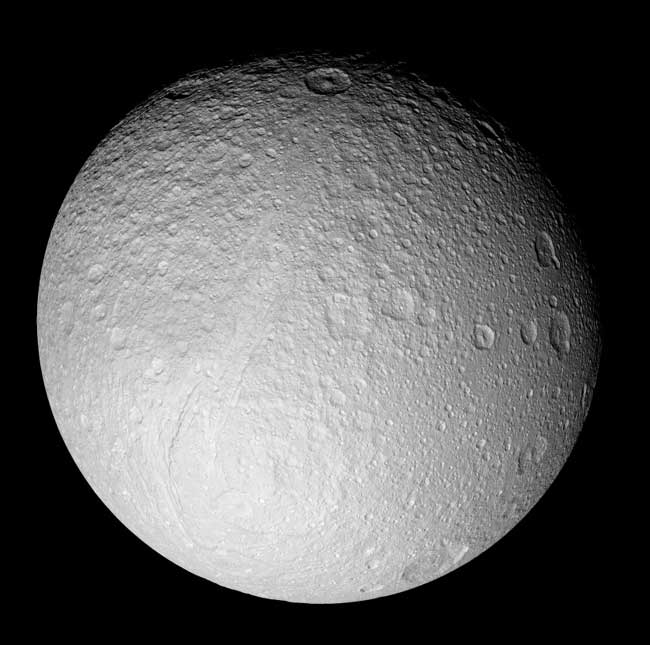New Pictures of Saturn’s Battered Moons

NASA's Cassini spacecraft has provided new images of Saturn'smoons Tethys and Hyperion, showing features not seenbefore.
Lastweekend, Cassini flew closer than ever before to eachof them.
Tethyshas a scarred, ancientsurface, an icy landscape with steep cliffs and craters.
A giantrift called IthacaChasma cuts across the disk of Tethys. Much of the topography in this region, includingthat of Ithaca Chasma, has been thoroughly hammeredby impacts. This appearance suggests that the event that created Ithaca Chasma happened very long ago.
A new imageof the Tethys' south polar region shows a region not photographedduring the Voyager era.
Astronomersdescribed Hyperionas spongy-looking with dark-floored craters that speckle its surface.Scientists don't know what the dark material is.
Inaddition, the new images suggest the possibility that Hyperion's crater wallshave experienced multiple episodes of landslides. Such "downslope" movement is evident in the filling ofcraters with debris and the near elimination of many craters along the steeperslopes.
Breaking space news, the latest updates on rocket launches, skywatching events and more!
Answers tothese questions may help solve the mystery of why this object has evolveddifferent surface forms from other moons of Saturn, scientists with SpaceScience Institute in Boulder, Colorado said in a statement today.
Cassiniflew by Hyperion at a distance of 310 miles (500 kilometers). Hyperion is 163miles (266 kilometers) wide. It has an irregular shape, and spins in a chaoticrotation. Much of its interior is empty space; it's like a pile of rubble,scientists say.
Cassiniwas within 930 miles (1,500 kilometers) of Tethys, amoon that is 665 miles (1,071 kilometers in diameter.

Space.com is the premier source of space exploration, innovation and astronomy news, chronicling (and celebrating) humanity's ongoing expansion across the final frontier. Originally founded in 1999, Space.com is, and always has been, the passion of writers and editors who are space fans and also trained journalists. Our current news team consists of Editor-in-Chief Tariq Malik; Editor Hanneke Weitering, Senior Space Writer Mike Wall; Senior Writer Meghan Bartels; Senior Writer Chelsea Gohd, Senior Writer Tereza Pultarova and Staff Writer Alexander Cox, focusing on e-commerce. Senior Producer Steve Spaleta oversees our space videos, with Diana Whitcroft as our Social Media Editor.
